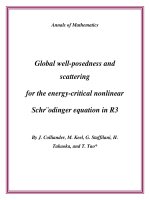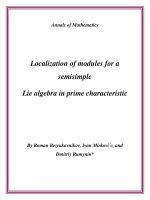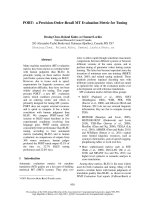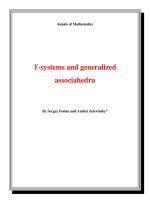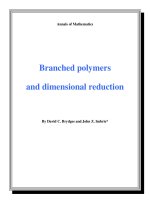Đề tài " Global existence and convergence for a higher order flow in conformal geometry" pptx
Bạn đang xem bản rút gọn của tài liệu. Xem và tải ngay bản đầy đủ của tài liệu tại đây (184.2 KB, 22 trang )
Annals of Mathematics
Global existence and convergence
for a higher order flow in
conformal geometry
By Simon Brendle
Annals of Mathematics, 158 (2003), 323–343
Global existence and convergence for a
higher order flow in conformal geometry
By Simon Brendle
1. Introduction
An important problem in conformal geometry is the construction of con-
formal metrics for which a certain curvature quantity equals a prescribed func-
tion, e.g. a constant. In two dimensions, the uniformization theorem assures
the existence of a conformal metric with constant Gauss curvature. More-
over, J. Moser [20] proved that for every positive function f on S
2
satisfying
f(x)=f(−x) for all x ∈ S
2
there exists a conformal metric on S
2
whose Gauss
curvature is equal to f.
A natural conformal invariant in dimension four is
Q = −
1
6
(∆R − R
2
+3|Ric|
2
),
where R denotes the scalar curvature and Ric the Ricci tensor. This formula
can also be written in the form
Q = −
1
6
(∆R − 6 σ
2
(A)),
where
A = Ric −
1
6
Rg
is the Schouten tensor of M and
σ
2
(A)=
1
2
(tr A)
2
−
1
2
|A|
2
is the second elementary symmetric polynomial in its eigenvalues. Under a
conformal change of the metric
g = e
2w
g
0
,
the quantity Q transforms according to
Q = e
−4w
(Q
0
+ P
0
w),
where P
0
denotes the Paneitz operator with respect to g
0
. The Gauss-Bonnet-
Chern theorem asserts that
M
QdV +
M
1
4
|W |
2
dV =8π
2
χ(M).
324 SIMON BRENDLE
Since the Weyl tensor W is conformally invariant, it follows that the expression
M
QdV
is conformally invariant, too. The quantity Q plays an important role in four-
dimensional conformal geometry; see [2], [3], [5], [16] (note that our notation
differs slightly from that in [2], [3]). Moreover, the Paneitz operator plays a
similar role as the Laplace operator in dimension two; compare [2], [3], [5],
[11], [12]. We also note that the Paneitz operator is of considerable interest in
mathematical physics, see [10, SSIV.4].
T. Branson, S Y. A. Chang and P. Yang [2] studied metrics for which the
curvature quantity Q is constant. Since
M
QdV
is conformally invariant, these metrics minimize the functional
M
Q
2
dV
among all conformal metrics with fixed volume. In addition, these metrics are
critical points of the functional
E
1
[w]=
M
2 wP
0
wdV
0
+
M
4 Q
0
wdV
0
−
M
Q
0
dV
0
log
M
e
4w
dV
0
,
where g
0
denotes a fixed metric on M and g = e
2w
g
0
.
According to the results in [2], one can construct conformal metrics of
constant Q-curvature by minimizing the functional E
1
[w] provided that the
Paneitz operator is weakly positive and the integral of the Q-curvature on M
is less than that on the standard sphere S
n
.Indimension four, M. Gursky [17]
proved that both conditions are satisfied if
Y (g
0
) ≥ 0
and
M
Q
0
dV
0
≥ 0,
and M is not conformally equivalent to the standard sphere S
4
.
C. Fefferman and R. Graham [14], [15] established the existence of a con-
formally invariant self-adjoint operator with leading term (−∆)
n
2
in all even
dimensions n. Moreover, there is a curvature quantity which transforms ac-
cording to
Q = e
−nw
(Q
0
+ P
0
w)
for
g = e
2w
g
0
.
GLOBAL EXISTENCE 325
This implies that the expression
M
QdV
is conformally invariant. Hence, a metric with Q = constant minimizes the
functional
M
Q
2
dV
among all conformal metrics with fixed volume. Finally, the analogue of the
functional E
1
[w]isgiven by
E
1
[w]=
M
n
2
wP
0
wdV
0
+
M
nQ
0
wdV
0
−
M
Q
0
dV
0
log
M
e
nw
dV
0
.
Our aim is to construct conformal metrics for which the curvature quan-
tity Q is a constant multiple of a prescribed positive function f on M . This
equation is the Euler-Lagrange equation for the functional
E
f
[w]=
M
n
2
wP
0
wdV
0
+
M
nQ
0
wdV
0
−
M
Q
0
dV
0
log
M
e
nw
fdV
0
.
We construct critical points of the functional E
f
[w] using the gradient flow for
E
f
[w]. A similar method was used by R. Ye [25] to prove Yamabe’s theorem
for locally conformally flat manifolds. K. Ecker and G. Huisken [13] used
avariant of mean curvature flow to construct hypersurfaces with prescribed
mean curvature in cosmological spacetimes.
The flow of steepest descent for the functional E
f
[w]isgiven by
∂
∂t
g = −
Q −
Qf
f
g.
Here,
Q and f denote the mean values of Q and f respectively, i.e.
M
(Q − Q) dV =0 and
M
(f − f) dV =0.
This evolution equation preserves the conformal structure of M . Moreover,
since
M
Q −
Qf
f
dV =
M
Q −
Q f
f
dV =0,
the volume of M remains constant. From this it follows that
Q is constant in
time. If we write g = e
2w
g
0
for a fixed metric g
0
, then the evolution equation
takes the form
∂
∂t
w = −
1
2
e
−nw
P
0
w −
1
2
e
−nw
Q
0
+
1
2
Qf
f
,
326 SIMON BRENDLE
where P
0
denotes the Paneitz operator with respect to g
0
. Therefore, the
function w satisfies a quasilinear parabolic equation of order n involving the
critical Sobolev exponent. Moreover, the reaction term is nonlocal, since
f
involves values of w on the whole of M .
Theorem 1.1. Assume that the Paneitz operator P
0
is weakly positive
with kernel consisting of the constant functions. Moreover, assume that
M
Q
0
dV
0
< (n − 1)! ω
n
.
Then the evolution equation
∂
∂t
g = −
Q −
Qf
f
g
has a solution which is defined for all times and converges to a metric with
Q
f
=
Q
f
.
On the standard sphere S
n
,wehave
M
QdV =(n − 1)! ω
n
;
hence Theorem 1.1 cannot be applied. In fact, the conclusion of Theorem 1.1
fails for M = S
n
.Tosee this, one can consider the Kazdan-Warner identity
S
n
∇
0
Q, ∇
0
x
j
e
nw
dV
0
=0;
see [3]. If f is an increasing function of x
j
, then
S
n
∇
0
Q, ∇
0
x
j
e
nw
dV
0
> 0.
Consequently, there is no conformal metric on S
n
satisfying
Q
f
=
Q
f
.
Nevertheless, the conclusion of Theorem 1.1 holds if f(x)=f(−x) and w(x)=
w(−x) for all x ∈ S
n
. This is a generalization of Moser’s theorem [20].
Theorem 1.2. Suppose that M = RP
n
. Then the evolution equation
∂
∂t
g = −
Q −
Qf
f
g
has a solution which is defined for all times and converges to a metric with
Q
f
=
Q
f
.
GLOBAL EXISTENCE 327
Combining Theorem 1.2 with M. Gursky’s result [17] gives
Theorem 1.3. Suppose that M is a compact manifold of dimension four
satisfying
Y (g
0
) ≥ 0 and
M
Q
0
dV
0
≥ 0.
Moreover, assume that M is not conformally equivalent to the standard sphere S
4
.
Then the evolution equation
∂
∂t
g = −
Q −
Qf
f
g
has a solution which is defined for all times and converges to a metric with
Q
f
=
Q
f
.
Finally, we prove a compactness theorem for conformal metrics on S
n
.In
two dimensions, the corresponding result was first established by X. Chen [6]
(see also [24]).
Proposition 1.4. Let g
k
= e
2w
k
g
0
beasequence of conformal metrics
on S
n
with fixed volume such that
S
n
Q
2
k
dV
k
≤ C.
Assume that for every point x ∈ S
n
there exists r>0 such that
lim
r→0
lim
k→∞
B
r
(x)
|Q
k
| dV
k
<
1
2
(n − 1)! ω
n
.
Then the sequence w
k
is uniformly bounded in H
n
.
The evolution equation can be viewed as a generalization of the Ricci flow
on compact surfaces. In dimension four, the quantity Q plays a similar role as
the Gauss curvature in dimension two. Moreover, the energy functional E
1
[w]
corresponds to the Liouville energy studied by B. Osgood, R. Phillips and P.
Sarnak in [21].
It was shown by R. Hamilton [18] and B. Chow [8] that every solution of
the Ricci flow on a compact surface exists for all time and converges exponen-
tially to a metric with constant Gauss curvature. A different approach was
introduced by X. Chen [6] in his work on the Calabi flow. Similar methods
were used by M. Struwe [24] to establish global existence and exponential con-
vergence for the Ricci flow on compact surfaces, and by X. Chen and G. Tian
[7] to prove convergence of the K¨ahler-Ricci flow on K¨ahler-Einstein surfaces.
For the Ricci flow, the situation is more complicated since the Calabi energy
is not decreasing along the flow. H. Schwetlick [23] used similar arguments
to deduce global existence and convergence for a natural sixth order flow on
surfaces. The approach used in [6] and [24] is based on integral estimates and
328 SIMON BRENDLE
does not rely on the maximum principle. These ideas are also useful in our
situation. This is due to the fact that the equation studied in this paper has
higher order, hence the maximum principle is not available.
In Section 2 we derive the evolution equation for the conformal factor and
the curvature quantity Q.InSection 3 we show that the solution is bounded
in H
n
2
.InSections 4 and 5 we show that the solution exists for all time, and
in Section 6 we prove that the evolution equation converges to a stationary
solution. Finally, the proof of Proposition 1.4 is carried out in Section 8.
The author would like to thank S Y. A. Chang and J. Viaclovsky for
helpful comments.
2. The evolution equations for w and Q −
Qf
f
Since the evolution equation preserves the conformal structure, we may
write g = e
2w
g
0
for a fixed metric g
0
and some real-valued function w. Then
we have the formula
Q = e
−nw
(Q
0
+ P
0
w),
where P
0
denotes the Paneitz operator with respect to the metric g
0
. Hence,
the function w obeys the evolution equation
∂
∂t
w = −
1
2
e
−nw
P
0
w −
1
2
e
−nw
Q
0
+
1
2
Qf
f
.
Differentiating both sides with respect to t,weobtain
∂
∂t
Q −
Qf
f
= −
1
2
P
Q −
Qf
f
+
n
2
Q
Q −
Qf
f
+
Qf
f
2
d
dt
f,
where P = e
−nw
P
0
is the Paneitz operator with respect to the metric g.It
follows from the evolution equation for w that
d
dt
f = −
M
n
2
f
Q −
Qf
f
dV.
This implies
∂
∂t
Q −
Qf
f
= −
1
2
P
Q −
Qf
f
+
n
2
Q
Q −
Qf
f
−
n
2
Qf
f
M
f
f
Q −
Qf
f
dV,
where P denotes the Paneitz operator with respect to the metric g.
GLOBAL EXISTENCE 329
3. Boundedness of w in H
n
2
We consider the functional
E
f
[w]=
M
n
2
wP
0
wdV
0
+
M
nQ
0
wdV
0
−
M
Q
0
dV
0
log
M
fe
nw
dV
0
.
Since P
0
is self-adjoint,
d
dt
E
f
[w]=
M
n
2
∂
∂t
wP
0
wdV
0
+
M
n
2
wP
0
∂
∂t
wdV
0
+
M
nQ
0
∂
∂t
wdV
0
−
M
n
Qf
f
∂
∂t
wdV
=
M
nP
0
w
∂
∂t
wdV
0
+
M
nQ
0
∂
∂t
wdV
0
−
M
n
Qf
f
∂
∂t
wdV
=
M
nQ
∂
∂t
wdV −
M
n
Qf
f
∂
∂t
wdV
=
M
n
Q −
Qf
f
∂
∂t
wdV.
Since the time derivative of w is given by
∂
∂t
w = −
1
2
Q −
Qf
f
,
we obtain
d
dt
E
f
[w]=−
M
n
2
Q −
Qf
f
2
dV.
In particular, the functional E
f
[w]isdecreasing under the evolution equation.
This implies
E
f
[w] ≤ C.
In the first step, we consider the case
M
Q
0
dV
0
< 0.
Using Jensen’s inequality we obtain
log
M
e
n(w−w)
dV
0
≥−C.
This implies
E
f
[w] ≥
M
n
2
wP
0
wdV
0
+
M
nQ
0
wdV
0
−
M
Q
0
dV
0
log
M
e
nw
dV
0
− C
330 SIMON BRENDLE
=
M
n
2
wP
0
wdV
0
+
M
nQ
0
(w − w) dV
0
−
M
Q
0
dV
0
log
M
e
n(w−w)
dV
0
− C
≥
M
n
2
wP
0
wdV
0
+
M
nQ
0
(w − w) dV
0
− C
≥ 2δ
M
(−∆
0
)
n
4
w
2
dV
0
+
M
nQ
0
(w − w) dV
0
− C
≥ δ
M
(−∆
0
)
n
4
w
2
dV
0
− C.
In the second step, we consider the case
0 ≤
M
Q
0
dV
0
< (n − 1)! ω
n
.
Since the Paneitz operator P
0
is self-adjoint and weakly positive, it has a square
root P
1
2
0
. Moreover, the kernel of P
1
2
0
coincides with the kernel of P
0
, which
consists of the constant functions. Thus, we conclude that
w(y) −
w =
M
P
1
2
0
w(z) H(y, z) dV
0
(z)
for a suitable function H(y,z). The leading term in the asymptotic expansion
of the kernel H(y, z) coincides with that of the Green’s function for the oper-
ator (−∆)
n
4
in R
n
. Hence, we can apply an inequality of D. Adams (see [1,
Theorems 1 and 2]). This implies
M
e
2
n
π
n
n
ω
n−1
(w−
w)
2
M
(P
1
2
0
w)
2
dV
0
dV
0
≤ C,
hence
M
e
2
n
π
n
n
ω
n−1
(w−
w)
2
M
wP
0
wdV
0
dV
0
≤ C.
Since
ω
n−1
ω
n
=
2
n+1
π
n
(n − 1)!
,
we obtain
M
e
n(w−w)
dV
0
≤ Ce
M
n
2(n−1)! ω
n
wP
0
wdV
0
.
From this it follows that
E
f
[w] ≥
M
n
2
wP
0
wdV
0
+
M
nQ
0
wdV
0
−
M
Q
0
dV
0
log
M
e
nw
dV
0
− C
GLOBAL EXISTENCE 331
=
M
n
2
wP
0
wdV
0
+
M
nQ
0
(w − w) dV
0
−
M
Q
0
dV
0
log
M
e
n(w−w)
dV
0
− C
≥
1 −
M
Q
0
dV
0
(n − 1)! ω
n
M
n
2
wP
0
wdV
0
+
M
nQ
0
(w − w) dV
0
− C
≥ 2δ
M
(−∆
0
)
n
4
w
2
dV
0
+
M
4 Q
0
(w − w) dV
0
− C
≥ δ
M
(−∆
0
)
n
4
w
2
dV
0
− C.
Since E
f
[w]isbounded from above, we conclude that
M
(−∆
0
)
n
4
w
2
dV
0
≤ C;
hence
w −
w
H
n
2
≤ C.
Using an inequality of N. Trudinger, we obtain
M
e
α(w−w)
dV
0
≤ C
for all real numbers α.Inparticular, we have
M
e
n(w−w)
dV
0
≤ C.
Since
M
e
nw
dV
0
=1, we conclude that e
−nw
≤ C; hence −C ≤ w ≤ C. This
implies w
H
n
2
≤ C and
M
e
αw
dV
0
≤ C for all real numbers α. Since the
functional E
f
[w]isbounded from below, we finally obtain
T
0
M
Q −
Qf
f
2
dV dt ≤ C.
4. Boundedness of w in H
n
for 0 ≤ t ≤ T
Let T beafixed, positive real number. We claim that
w
H
n
≤ C
for all 0 ≤ t ≤ T .For the sake of brevity, we put
v = −
1
2
e
nw
2
Q −
Qf
f
= e
nw
2
∂
∂t
w
= −
1
2
e
−
nw
2
P
0
w −
1
2
e
−
nw
2
Q
0
+
1
2
e
nw
2
Qf
f
.
332 SIMON BRENDLE
This implies
∂
∂t
w = e
−
nw
2
v and P
0
w = −2 e
nw
2
v − Q
0
+ e
nw
Qf
f
.
From this it follows that
d
dt
M
(P
0
w)
2
dV
0
= −
M
4(e
nw
2
v) P
0
(e
−
nw
2
v) dV
0
−
M
2 Q
0
P
0
(e
−
nw
2
v)
+
M
2 Q
f
(e
nw
f) P
0
(e
−
nw
2
v) dV
0
.
This implies
d
dt
M
(P
0
w)
2
dV
0
= −
M
4(−∆
0
)
n
4
(e
nw
2
v)(−∆
0
)
n
4
(e
−
nw
2
v) dV
0
−
M
2 P
0
Q
0
(e
−
nw
2
v)
+
M
2 Q
f
(−∆
0
)
n
4
(e
nw
f)(−∆
0
)
n
4
(e
−
nw
2
v) dV
0
+lower order terms.
Here, we adopt the convention that
(−∆
0
)
m+
1
2
= ∇
0
(−∆
0
)
m
for all integers m (see [1]). The right-hand side involves derivatives of v and
w of order at most
n
2
. Moreover, the total number of derivatives is at most n.
Therefore, we obtain
d
dt
M
(P
0
w)
2
dV
0
= −
M
4
(−∆
0
)
n
4
v
2
dV
0
+C
k
1
, ,k
m
M
|∇
k
1
0
v|·|∇
k
2
0
v|·|∇
k
3
0
w|···|∇
k
m
0
w| dV
0
+C
l
1
, ,l
m
M
|∇
l
1
0
v|·|∇
l
2
0
w|···|∇
l
m
0
w| e
αw
dV
0
.
The first sum is taken over all m-tuples k
1
, ,k
m
with m ≥ 3 satisfying the
conditions
0 ≤ k
i
≤
n
2
for 1 ≤ i ≤ 2,
1 ≤ k
i
≤
n
2
for 3 ≤ i ≤ m,
and
k
1
+ ···+ k
m
≤ n.
GLOBAL EXISTENCE 333
To estimate this term, we choose real numbers p
1
, ,p
m
∈ [2, ∞[ such that
k
i
≤
n
p
i
for 1 ≤ i ≤ 2,
n
p
i
<k
i
for 3 ≤ i ≤ m
and
1
p
1
+ ···+
1
p
m
=1.
Moreover, we define real numbers θ
1
, ,θ
m
by
θ
i
=
k
i
−
n
p
i
+
n
2
n
2
∈ [0, 1] for 1 ≤ i ≤ 2
and
θ
i
=
k
i
−
n
p
i
n
2
∈ ]0, 1[ for 3 ≤ i ≤ m.
Then we have θ
1
+ ···+ θ
m
≤ 2; hence
θ
3
+ ···+ θ
m
≤ (1 − θ
1
)+(1− θ
2
).
Since w is bounded in H
n
2
, this implies
−
M
2
(−∆
0
)
n
4
v
2
dV
0
+C
k
1
, ,k
m
M
|∇
k
1
0
v|·|∇
k
2
0
v|·|∇
k
3
0
w|···|∇
k
m
0
w| dV
0
≤−v
2
H
n
2
+ C
k
1
, ,k
m
∇
k
1
0
v
L
p
1
·∇
k
2
0
v
L
p
2
·∇
k
3
0
w
L
p
3
···∇
k
m
0
w
L
p
m
≤−v
2
H
n
2
+ C
k
1
, ,k
m
v
H
k
1
−
n
p
1
+
n
2
·v
H
k
2
−
n
p
2
+
n
2
·w
H
k
3
−
n
p
3
+
n
2
···w
H
k
m
−
n
p
m
+
n
2
≤−v
2
H
n
2
+ C
k
1
, ,k
m
v
(1−θ
1
)+(1−θ
2
)
L
2
·v
θ
1
+θ
2
H
n
2
w
(1−θ
3
)+···+(1−θ
m
)
H
n
2
w
θ
3
+···+θ
m
H
n
≤−v
2
H
n
2
+ C
k
1
, ,k
m
v
(1−θ
1
)+(1−θ
2
)
L
2
v
θ
1
+θ
2
H
n
2
w
θ
3
+···+θ
m
H
n
≤ C
k
1
, ,k
m
v
2
L
2
w
2(θ
3
+···+θ
m
)
(1−θ
1
)+(1−θ
2
)
H
n
≤ C v
2
L
2
(w
2
H
n
+1).
334 SIMON BRENDLE
The second sum is taken over all m-tuples l
1
, ,l
m
with m ≥ 1 satisfying the
conditions
0 ≤ l
1
≤
n
2
,
1 ≤ l
i
≤
n
2
for 2 ≤ i ≤ m
and
l
1
+ ···+ l
m
≤ n.
To estimate this term, we choose real numbers q
1
, ,q
m
∈ [2, ∞[ such that
l
1
≤
n
q
1
,
n
q
i
<l
i
for 2 ≤ i ≤ m
and
1
2
≤
1
q
1
+ ···+
1
q
m
< 1.
Moreover, we define real numbers ρ
2
, ,ρ
m
by
ρ
1
=
l
1
−
n
q
1
+
n
2
n
2
∈ [0, 1]
and
ρ
i
=
l
i
−
n
q
i
n
2
∈ ]0, 1[ for 2 ≤ i ≤ m.
Then we have ρ
1
+ ···+ ρ
m
≤ 2; hence ρ
2
+ ···+ ρ
m
≤ 2 − ρ
1
. Since w is
bounded in H
n
2
, this implies
−
M
2
(−∆
0
)
n
4
v
2
dV
0
+ C
l
1
, ,l
m
M
|∇
l
1
0
v|·|∇
l
2
0
w|···|∇
l
m
0
w| e
αw
dV
0
≤−v
2
H
n
2
+ C
l
1
, ,l
m
∇
l
1
0
v
L
q
1
·∇
l
2
0
w
L
q
2
···∇
l
m
0
w
L
q
m
≤−v
2
H
n
2
+ C
l
1
, ,l
m
v
H
l
1
−
n
q
1
+
n
2
·w
H
l
2
−
n
q
2
+
n
2
···w
H
l
m
−
n
q
m
+
n
2
≤−v
2
H
n
2
+ C
l
1
, ,l
m
v
1−ρ
1
L
2
v
ρ
1
H
n
2
w
(1−ρ
2
)+···+(1−ρ
m
)
H
n
2
w
ρ
2
+···+ρ
m
H
n
≤−v
2
H
n
2
+ C
l
1
, ,l
m
v
1−ρ
1
L
2
v
ρ
1
H
n
2
w
ρ
2
+···+ρ
m
H
n
≤ C
l
1
, ,l
m
v
2−2ρ
1
2−ρ
1
L
2
w
2(ρ
2
+···+ρ
m
)
2−ρ
1
H
n
≤ C (v
2
L
2
+1)(w
2
H
n
+1).
Thus, we conclude that
d
dt
M
(P
0
w)
2
dV
0
≤ C (v
2
L
2
+1)(w
2
H
n
+1).
GLOBAL EXISTENCE 335
From the positivity of P
0
it follows that
w
2
H
n
≤ C
M
(P
0
w)
2
dV
0
.
Moreover, the function v satisfies
v
2
L
2
=
M
1
4
e
nw
Q −
Qf
f
2
dV
0
=
M
1
4
Q −
Qf
f
2
dV.
Therefore, we obtain
d
dt
M
(P
0
w)
2
dV
0
+1
≤ C
M
(P
0
w)
2
dV
0
+1
M
Q −
Qf
f
2
dV +1
.
Since
T
0
M
Q −
Qf
f
2
dV dt ≤ C,
we deduce that
M
(P
0
w)
2
dV
0
≤ C for all 0 ≤ t ≤ T.
This implies
w
H
n
≤ C
for all 0 ≤ t ≤ T . Using the Sobolev inequality, we obtain
|w|≤C for all 0 ≤ t ≤ T.
5. Boundedness of w in H
2k
for 0 ≤ t ≤ T
We now establish bounds for the higher order derivatives:
d
dt
M
|(−∆
0
)
k
w|
2
dV
0
≤−
M
e
−nw
|(−∆
0
)
k+
n
4
w|
2
dV
0
+C
k
1
, ,k
m
M
|∇
k
1
0
w|···|∇
k
m
0
w| dV
0
;
hence
d
dt
M
|(−∆
0
)
k
w|
2
dV
0
≤−
1
C
M
|(−∆
0
)
k+
n
4
w|
2
dV
0
+C
k
1
, ,k
m
M
|∇
k
1
0
w|···|∇
k
m
0
w| dV
0
.
Here, the sum is taken over all m-tuples k
1
, ,k
m
, with m ≥ 3, which satisfy
the conditions
1 ≤ k
i
≤ 2k +
n
2
and k
1
+ ···+ k
m
≤ 4k + n.
336 SIMON BRENDLE
We now choose real numbers p
1
, ,p
m
∈ [2, ∞[ such that
k
i
≤ 2k +
n
p
i
and
1
p
1
+ ···+
1
p
m
=1.
Moreover, we define real numbers θ
1
, ,θ
m
by
θ
i
= max
k
i
−
n
p
i
−
n
2
2k −
n
2
, 0
.
Since m ≥ 3, we can choose p
1
, ,p
m
∈ [2, ∞[ such that
θ
1
+ ···+ θ
m
< 2.
From this it follows that
d
dt
w
2
H
2k
≤−
1
C
w
2
H
2k+
n
2
+ C
k
1
, ,k
m
∇
k
1
0
w
L
p
1
···∇
k
m
0
w
L
p
m
≤−
1
C
w
2
H
2k+
n
2
+ C
k
1
, ,k
m
w
H
k
1
−
n
p
1
+
n
2
···w
H
k
m
−
n
p
m
+
n
2
≤−
1
C
w
2
H
2k+
n
2
+ C
k
1
, ,k
m
w
(1−θ
1
)+···+(1−θ
m
)
H
n
w
θ
1
+···+θ
m
H
2k+
n
2
≤−
1
C
w
2
H
2k+
n
2
+ C
k
1
, ,k
m
w
θ
1
+···+θ
m
H
2k+
n
2
≤−
1
C
w
2
H
2k+
n
2
+ C
≤−
1
C
w
2
H
2k
+ C
for all 0 ≤ t ≤ T .Thus, we conclude that
w
H
2k
≤ C for all 0 ≤ t ≤ T.
Therefore, the evolution equation has a solution which is defined for all time.
6. Convergence
For the sake of brevity, we put
y(t)=
M
Q −
Qf
f
2
dV
and we show that
y(t) → 0 for t →∞.
Let ε be an arbitrary positive number. We choose t
0
≥ 0 such that y(t
0
) ≤ ε.
We claim that y(t) ≤ 3ε for all t ≥ t
0
. Otherwise, we define
t
1
= inf{t ≥ t
0
: y(t) ≥ 3ε}.
GLOBAL EXISTENCE 337
This implies y(t) ≤ 3ε for all t
0
≤ t ≤ t
1
.From this it follows that
M
e
−nw
(Q
0
+ P
0
w)
2
dV
0
≤ C
for all t
0
≤ t ≤ t
1
. Moreover, it follows from results in Section 3 that
M
e
3nw
dV
0
≤ C for all t
0
≤ t ≤ t
1
.
Using H¨older’s inequality, we obtain
M
|Q
0
+ P
0
w|
3
2
dV
0
≤
M
e
−nw
(Q
0
+ P
0
w)
2
dV
0
3
4
M
e
3nw
dV
0
1
4
.
From this it follows that
M
|P
0
w|
3
2
dV
0
≤ C for all t
0
≤ t ≤ t
1
.
Using the Sobolev inequality, we obtain
|w|≤C for all t
0
≤ t ≤ t
1
.
We have shown in Section 2 that the function Q−
Qf
f
satisfies the evolution
equation
∂
∂t
Q −
Qf
f
= −
1
2
P
Q −
Qf
f
+
n
2
Q
Q −
Qf
f
−
n
2
Qf
f
M
f
f
Q −
Qf
f
dV,
where P denotes the Paneitz operator with respect to the metric g.From this
it follows that
d
dt
M
Q −
Qf
f
2
dV
= −
M
Q −
Qf
f
P
Q −
Qf
f
dV
+
M
n
2
Q −
Qf
f
3
dV.
+
M
n
Qf
f
Q −
Qf
f
2
dV
−n
Q
M
f
f
Q −
Qf
f
dV
2
.
Using the Gagliardo-Nirenberg inequality, we can bound
Q −
Qf
f
L
3
≤ C
Q −
Qf
f
2
3
L
2
Q −
Qf
f
1
3
H
n
2
,
338 SIMON BRENDLE
where the norms are taken with respect to the background metric g
0
. This
implies
M
Q −
Qf
f
3
dV
0
≤ C
M
Q −
Qf
f
2
dV
0
M
Q −
Qf
f
P
0
Q −
Qf
f
dV
0
1
2
.
Since w is uniformly bounded for t
0
≤ t ≤ t
1
,weobtain
M
Q −
Qf
f
3
dV
≤ C
M
Q −
Qf
f
2
dV
M
Q −
Qf
f
P
Q −
Qf
f
dV
1
2
.
Thus, we conclude that
d
dt
M
Q −
Qf
f
2
dV
≤ C
M
Q −
Qf
f
2
dV
2
+C
M
Q −
Qf
f
2
dV
;
hence
d
dt
y(t) ≤ Cy(t)
2
+ Cy(t).
Therefore, we obtain
2ε ≤ y(t
1
) − y(t
0
) ≤ C
t
1
t
0
y(t) dt.
If we choose t
0
large enough, then we have
C
∞
t
0
y(t) dt ≤ ε.
Hence, we obtain 2ε ≤ ε which is a contradiction. Thus, we conclude that
y(t) → 0 for t →∞.
From this it follows that
|w|≤C for all t ≥ 0.
Moreover, we have
M
e
−nw
(Q
0
+ P
0
w)
2
dV
0
≤ C
for all t ≥ 0. From this it follows that
M
(Q
0
+ P
0
w)
2
dV
0
≤ C;
GLOBAL EXISTENCE 339
hence
w
H
n
≤ C
for all t ≥ 0. Arguing as above, we obtain
w
H
k
≤ C for all t ≥ 0.
It remains to show that the flow converges to a metric satisfying
Q
f
=
Q
f
.
The evolution equation
∂
∂t
g = −
Q −
Qf
f
g
is the gradient flow for the functional
E
f
[w]=
M
n
2
wP
0
wdV
0
+
M
nQ
0
wdV
0
−
M
Q
0
dV
0
log
M
e
nw
fdV
0
.
Since the functional E
f
[w]isreal analytic, the assertion follows from a general
result of L. Simon [22].
7. The case M = RP
n
In this section, we consider the special case M = RP
n
.Wenormalize the
metric such that the volume of M is equal to
1
2
ω
n
and the mean value of the
function Q is equal to (n − 1)!. By Theorem 1.1, the flow converges to a limit
metric g satisfying
Q
f
=
(n − 1)!
f
.
In particular, for every positive function f on RP
n
, there exists a metric g on
RP
n
such that
Q
f
=
(n − 1)!
f
.
We now consider the case f =1.Inthis case, the limit metric g satisfies
Q =(n − 1)!. It follows from a result of S Y. A. Chang and P. Yang [4]
(see also C. S. Lin’s paper [19]) that the limit metric is the standard metric
on RP
n
.
We claim that the flow converges exponentially. To show this, we denote
by g
0
the standard metric on RP
n
. Then the conformal factor satisfies the
evolution equation
∂
∂t
w = −
1
2
e
−nw
P
0
w +
1
2
(n − 1)! (1 − e
−nw
).
340 SIMON BRENDLE
Linearizing this equation, we obtain
∂
∂t
w = −
1
2
P
0
w +
1
2
n! w.
The Paneitz operator on RP
n
is given by
P
0
=
n
2
k=1
(−∆
0
+(k − 1)(n − k)).
The first eigenvalue of the Laplace operator −∆
0
on RP
n
is strictly greater
than n. Hence, the first eigenvalue of the Paneitz operator P
0
is strictly greater
than n!. Therefore, the first eigenvalue of the linearized operator is strictly
less than 0. Thus, we conclude that the flow converges exponentially to the
standard metric on RP
n
.
8. A compactness result for conformal metrics on S
n
In this section, we give a proof for Proposition 1.4. Let g
k
= e
2w
k
g
0
be a
sequence of conformal metrics on S
n
with fixed volume such that
S
n
Q
2
k
dV
k
≤ C.
Since
Q
k
= e
−nw
k
(Q
0
+ P
0
w
k
),
we obtain
S
n
e
−nw
k
(Q
0
+ P
0
w
k
)
2
dV
0
≤ C.
Moreover, we have
S
n
|Q
k
| dV
k
≤ C.
Hence
S
n
|P
0
w
k
| dV
0
≤ C.
Finally, we have
lim
r→0
lim
k→∞
B
r
(x)
|Q
k
| dV
k
<
1
2
(n − 1)! ω
n
.
This implies
lim
r→0
lim
k→∞
B
r
(x)
|P
0
w
k
| dV
0
<
1
2
(n − 1)! ω
n
.
Choosing r sufficiently small, we obtain
lim
k→∞
B
r
(x)
|P
0
w
k
| dV
0
<
1
2
(n − 1)! ω
n
.
GLOBAL EXISTENCE 341
Let
I
k
=
B
r
(x)
|P
0
w
k
| dV
0
.
We now use the formula
w
k
(y) − w
k
=
S
n
P
0
w
k
(z) K(y, z) dV
0
(z).
This implies
np(w
k
(y) − w
k
) ≤
B
r
(x)
np |P
0
w
k
(z)||K(y,z)| dV
0
(z)+C
for all y ∈ B
r
2
(x). Using Jensen’s inequality, we obtain
e
np(w
k
(y)−w
k
)
≤
C
I
k
B
r
(x)
|P
0
w
k
(z)| e
npI
k
|K(y,z)|
dV
0
(z)
for all y ∈ B
r
2
(x). Since
lim
k→∞
I
k
<
1
2
(n − 1)! ω
n
,
we can find a real number p>1 such that
lim
k→∞
pI
k
<
1
2
(n − 1)! ω
n
.
We now use an asymptotic formula of the function K(y, z) for |y − z|→0. To
derive this formula, we use the identity
(−∆)
n
2
log |y − z| = −2
n−2
n − 2
2
!
2
ω
n−1
δ(y − z).
This implies
(−∆)
n
2
log |y − z| = −
1
2
(n − 1)! ω
n
δ(y − z).
Therefore, we obtain
1
2
(n − 1)! ω
n
K(y, z) ∼−log |y − z|;
hence
e
1
2
(n−1)! ω
n
|K(y,z)|
∼
1
|y − z|
.
From this it follows that
S
n
e
npI
k
|K(y,z)|
dV
0
(y) ≤ C.
Since
1
I
k
B
r
(x)
|P
0
w
k
| dV
0
=1,
342 SIMON BRENDLE
we conclude that
B
r
2
(x)
e
np(w
k
(y)−w
k
)
dV
0
(y) ≤ C.
Covering S
n
with finitely many balls B
r
2
(x), we obtain
S
n
e
np(w
k
−w
k
)
dV
0
≤ C
for some p>1. In particular, we have
S
n
e
n(w
k
−w
k
)
dV
0
≤ C.
Since
S
n
e
nw
k
dV
0
=1, we conclude that e
−nw
k
≤ C; hence −C ≤ w
k
≤ C.
This implies
S
n
e
npw
k
dV
0
≤ C.
By H¨older’s inequality,
S
n
|Q
0
+P
0
w
k
|
2p
p+1
dV
0
≤
S
n
e
−nw
k
(Q
0
+P
0
w
k
)
2
dV
0
p
p+1
S
n
e
npw
k
dV
0
1
p+1
.
From this it follows that
S
n
|P
0
w
k
|
2p
p+1
dV
0
≤ C.
Using the Sobolev inequality, we obtain |w
k
|≤C. Thus, we conclude that
S
n
|P
0
w
k
|
2
dV
0
≤ C.
Therefore, the sequence w
k
is uniformly bounded in H
n
.
Princeton University, Princeton, NJ
E-mail address:
References
[1] D. Adams,Asharp inequality of J. Moser for higher order derivatives, Ann. of Math.
128 (1988), 385–398.
[2]
T. Branson, S Y. A. Chang, and P. Yang, Estimates and extremals for zeta function
determinants on four-manifolds, Comm. Math. Phys. 149 (1992), 241–262.
[3]
S Y. A. Chang and P. Yang, Extremal metrics of zeta function determinants on
4-manifolds, Ann. of Math. 142 (1995), 171–212.
[4]
,Onuniqueness of solutions of nth order differential equations in conformal
geometry, Math. Res. Lett. 4 (1997), 91–102.
[5]
S Y. A. Chang, M. Gursky, and P. Yang,Anequation of Monge-Amp`ere type in confor-
mal geometry, and four-manifolds of positive Ricci curvature, Ann. of Math. 155 (2002),
709–787.
[6]
X. Chen, Calabi flow in Riemann surfaces revisited: a new point of view, Internat. Math.
Res. Notices (2001), no. 6, 275–297.
GLOBAL EXISTENCE 343
[7] X. Chen and G. Tian, Ricci flow on K¨ahler-Einstein surfaces, Invent. Math. 147 (2002),
487–544.
[8]
B. Chow, The Ricci flow on the 2-sphere, J. Differential Geom. 33 (1991), 325–334.
[9]
P. Chru
´
sciel, Semi-global existence and convergence of solutions of the Robinson-Trautman
(2-dimensional Calabi) equation, Comm. Math. Phys. 137 (1991), 289–313.
[10]
A. Connes, Noncommutative Geometry, Academic Press, San Diego, CA (1994).
[11]
Z. Djadli, A. Malchiodi, and M. Ahmedou, Prescribing a fourth order conformal invariant
on the standard sphere – Part I: a perturbation result, Commun. Contemp. Math. 4
(2002), 375–408.
[12]
, Prescribing a fourth order conformal invariant on the standard sphere, Part II:
blow-up analysis and applications, preprint (2000).
[13]
K. Ecker and G. Huisken,Parabolic methods for the construction of spacelike slices of
prescribed mean curvature in cosmological spacetimes, Comm. Math. Phys. 135 (1991),
595–613.
[14]
C. Fefferman and C. R. Graham, Conformal invariants, in The Mathematical Heritage
of
´
Elie Cartan (Lyon, 1984), Ast´erisque (1985), 95–116.
[15]
, Q-curvature and Poincar´e metrics, Math. Res. Lett. 9 (2002), 139–151.
[16]
M. Gursky, The Weyl functional, de Rham cohomology, and K¨ahler-Einstein metrics,
Ann. of Math. 148 (1998), 315–337.
[17]
M. Gursky, The principal eigenvalue of a conformally invariant differential operator, with
an application to semilinear elliptic PDE, Comm. Math. Phys. 207 (1999), 131–143.
[18]
R. Hamilton, The Ricci flow on surfaces, in Mathematics and General Relativity (Santa
Cruz, CA, 1986), Contemp. Math. 71 (1988), 237–262.
[19]
C. S. Lin,Aclassification of solutions of a conformally invariant fourth order equation
in R
n
, Comment. Math. Helv. 73 (1998), 206–231.
[20]
J. Moser,Onanonlinear problem in differential geometry, in Dynamical Systems
(M. Peixoto, ed.), 273–280, Academic Press, New York (1973).
[21]
B. Osgood, R. Phillips, and P. Sarnak, Extremals of determinants of Laplacians,
J. Funct. Anal. 80 (1988), 148–211.
[22]
L. Simon, Asymptotics for a class of nonlinear evolution equations, with applications to
geometric problems, Ann. of Math. 118 (1983), 525–571.
[23]
H. Schwetlick, Higher order curvature flows on surfaces, preprint (2001).
[24]
M. Struwe, Curvature flows on surfaces, preprint (2000).
[25]
R. Ye, Global existence and convergence of Yamabe flow, J. Differential Geom. 39 (1994),
35–50.
(Received January 24, 2002)



